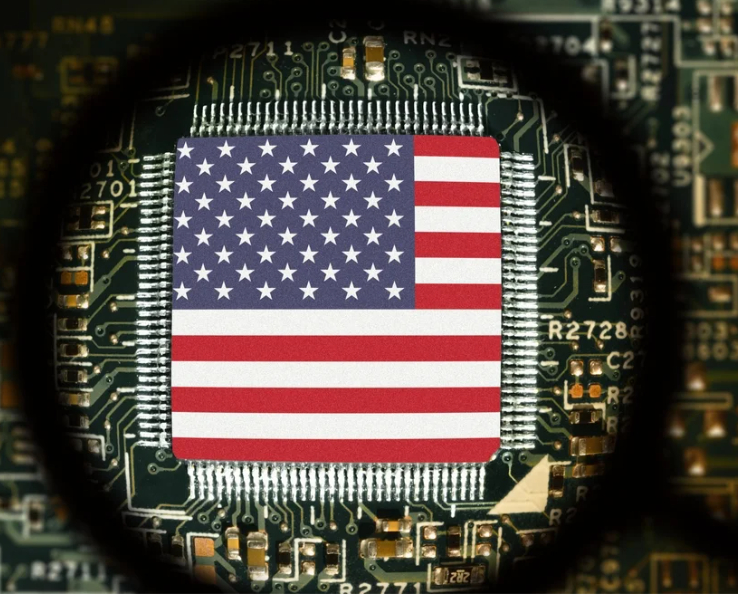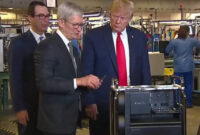The recent trade tariffs imposed by the current US administration on “Liberation Day” against trade partners have raised concerns about finances being even more constrained.
Let’s recall the tariffs as detailed on the large poster board prop featured during the event.
We’ll set aside the somewhat vague middle column that appears to represent the US goods-only trade deficit with each country — which is significant since the US operates as a service economy, exporting more intangibles like software, services, and entertainment rather than physical goods — and which is utilized as a gauge for alleged unfair practices.
A few observations to consider:
To begin with, China tops the list and will face a 34% “discounted reciprocal tariff.”
Additionally, if you’re considering upgrading your electronics, now might be the time to do it—here’s why.
If you look around at your possessions, you’ll notice that many items are made there.
Moving down the chart, Taiwan faces a 32% tariff.
This is significant for two reasons. Firstly, many products with “Made in China” labels contain electronic parts sourced from Taiwan. The second reason is that the Chinese Communist Party (CCP) regards Taiwan as a breakaway province it intends to control eventually, thus, including the name on the list will not be well-received by the CCP.
Two other notable countries relevant to this discussion are India and Vietnam, which will experience tariffs of 26% and 46%, respectively.
How could the tariffs impact the cost of your next iPhone?
Apple supply chain analyst Ming-Chi Kuo from TF International Securities took to social media to clarify the situation.
As Kuo points out, approximately 85 to 90% of Apple’s hardware assembly takes place in China, with the remainder occurring in India and Vietnam. Should Apple absorb the tariff fees and maintain current prices, its overall gross margin could see a significant reduction of around 8.5 to 9%.
Kuo is quite certain that China is unlikely to receive any concessions from the Trump administration regarding tariff exclusions, but there is a silver lining. By the end of 2025, he predicts that at least 15% of global iPhone production will move to India (up from 10 to 12% in 2024), and since India and Vietnam are more likely to qualify for tariff exemptions, the gross margin impact would lessen to about 5.5 to 6%.
Furthermore, if India and Vietnam obtain tariff exemptions, it would definitely accelerate Apple’s transition from China. If Apple manages to transfer 30% of its global manufacturing to these nations, the gross margin impact would shrink to only 1 to 3%.
However, Kuo believes that Apple has additional strategies to reduce the effects of the tariffs. The company could apply more pressure on supply chain manufacturers to lower costs, increase carrier subsidies, or reduce trade-in discounts, all of which would assist in softening or entirely negating price hikes.
Kuo is confident that even if these tariffs force Apple’s gross margin to fall below 40%, the decline will likely be temporary, and that margins will remain above 40% in the long run.
Moreover, Kuo emphasizes that high-end iPhones represent about 70% of new model sales, and that consumers in this segment tend to be more accepting of price increases.
However, (and this is a significant point)
All this overlooks several factors, such as the ease or difficulty for countries to obtain tariff exemptions and whether Apple itself might be able to negotiate its own exclusions (after all, Apple is the largest taxpayer in the US and globally, and Apple CEO Tim Cook personally donated $1 million to the Trump-Vance inaugural fund).
Also, we have no insight into what the global repercussions of these tariffs will entail. As of the time of writing, China has implemented 34% retaliatory tariffs along with export restrictions on seven types of rare-earth elements, including samarium, gadolinium, and terbium (which are utilized in manufacturing magnets and solid-state electronics, among other applications), set to take effect on April 10. This is likely just the start of the retaliatory measures.
As global trade tensions escalate, the likelihood increases that the price of your next iPhone will rise. The key question is: by how much?
This scenario does not factor in the escalating hostilities between China and Taiwan, which could substantially disrupt the global semiconductor landscape.
Semiconductors have been exempted from U.S. tariffs, alleviating some fears for the chip sector.
Taiwan’s semiconductor sector has received temporary relief, as semiconductors are among the imports excluded from the latest wave of tariffs introduced by U.S. President Donald Trump, an analyst noted Thursday.
The exemption for semiconductors offers a glimpse into Trump’s negotiating style, according to equity analyst Andy Hsu in an interview with CNA from Taipei.
“Initially, Trump issued some threats regarding tariffs, then TSMC (Taiwan Semiconductor Manufacturing Co.) promised significant investments in the U.S.,” Hsu explained, referencing TSMC’s announcement on March 3 regarding an additional investment of US$100 billion in Arizona over the coming years.
“At least for now, Taiwan’s semiconductor industry can enjoy a short period of relief,” Hsu remarked. “However, given Trump’s unpredictable nature, uncertainties persist, so I don’t believe the sector can afford to stop worrying about tariff threats for too long.”
Additionally, there are worries about whether Trump will retract the funding that was committed by the previous administration for semiconductor initiatives like TSMC’s under the CHIPS and Science Act, Hsu mentioned.
According to U.S. Commerce Secretary Howard Lutnick in a recent report, the White House aims to secure billions more in commitments without needing to broaden such grants.
On Wednesday, Trump declared broad “reciprocal tariffs” targeting the U.S.’ trading partners, which includes a 32 percent tax on products from Taiwan set to commence on April 9.
During an event in the Rose Garden, Trump announced a baseline 10 percent tax on imports from every country, scheduled to start on April 5. Nations with larger trade surpluses with the U.S. will face steeper tariffs beginning April 9, including Taiwan (32 percent), China (34 percent), Japan (24 percent), South Korea (25 percent), Vietnam (46 percent), and Thailand (36 percent), according to the White House.
An industry expert told CNA on Thursday that the U.S. government may urge Taiwanese semiconductor manufacturers to reduce the pricing of their products and services, which encompasses areas like pure wafer foundries, IC design, packaging, and testing sectors.
While larger suppliers may manage to cut prices to satisfy U.S. demands, smaller suppliers might struggle to implement significant reductions, potentially leading to decreased shipments or even exiting the market altogether, the expert stated, who requested anonymity.
Meanwhile, the response of TSMC to the latest U.S. tariff regulations will be closely monitored, as the company is set to hold an investor conference on April 17, where it will announce its earnings for the first quarter, provide forecasts for the second quarter and the entire year, and address crucial investor inquiries regarding U.S. tariffs.
Under TSMC’s US$100 billion investment initiative, the company intends to construct three additional advanced wafer fabrication plants, two IC assembly facilities, and one research and development center in Arizona, raising its total investment there to US$165 billion.
The chip manufacturer is already investing US$65 billion in Arizona for three wafer fabs, with the first expected to begin mass production by the end of 2024, utilizing advanced 4 nanometer technology.
The second fab is currently under construction, expected to commence commercial production in 2028, employing more advanced processes like 3 nm, 2 nm, and A16. TSMC’s Vice President for global policy, Peter Cleveland, stated last week that the company is looking to start construction on the third fab as soon as feasible.
Trump has publicly suggested multiple times that TSMC’s investments in the U.S. could reach US$200 billion or even US$300 billion, raising concerns among analysts about whether the Taiwanese company will increase its financial commitment in the U.S. amid looming tariff threats.
Analysts have expressed additional concerns regarding the potential leaking of TSMC’s trade secrets if it succumbs to U.S. government pressure to invest in Intel Corp.’s factories in order to bolster the American chipmaker’s pure play foundry operations.
A series of new tariff announcements is anticipated on April 2, referred to as Liberation Day by Trump, marking the administration’s most significant retreat from US open trade policy towards trade protectionism.
These remarks follow a statement made in February, indicating that Trump might enact a “25% or higher” tariff on all semiconductors imported into the United States. The prevailing perspective that suggests not believing Trump at his word represents the best-case scenario for the global tech industry.
Numerous leaders in the tech sector argue that imposing tariffs on semiconductors and on nations crucial to the chip supply to the US would harm the United States itself, while others view it as a means of correcting the global trade imbalance.
Where would tariffs on chips cause the greatest harm? Bill Rojas, the GlobalData Strategic Intelligence research director, asserts that tariffs on Chinese chips would not affect high-end products in the US, noting that China contributes less than 8% of the global supply chain.
However, the majority, if not all, major chips—including CPUs, GPUs, HBM, and DDR RAM—are sourced from Taiwan, Japan, or Korea. For instance, Qualcomm Snapdragon chips and the processors for Apple iPhones as well as NVIDIA GPU chips are produced by TSMC or other Taiwanese manufacturers, according to Rojas. “In essence, nearly all premium consumer and data center products would face penalties if Taiwan were subjected to tariffs. Thus, imposing tariffs on Taiwan would be self-defeating,” he asserts.
The factors influencing the global semiconductor supply chain have become exceedingly complicated, troubled, and tied to geopolitical issues. Both intellectual property and manufacturing have fallen under the scrutiny of the Trump administration’s protective strategies.
On March 27, the US included over 50 Chinese technology firms on its export blacklist in an effort to restrict China’s capacity to advance its technology, particularly in AI. At least 13 entities listed are linked to semiconductor production.
According to the US Bureau of Industry and Security, 12 entities—11 located in China and one in Taiwan—were included for their participation in developing advanced AI, supercomputers, and high-performance AI chips for end-users in China closely connected to the country’s military-industrial sector. Two Chinese organizations were added for selling products to those on the blacklist, including Huawei and its related fabless semiconductor company, HiSilicon.
Tariffs on chips will disrupt the global supply chain. The transfer of knowledge to the US and chip manufacturing capacity were central to the Biden administration’s CHIPS Act, which incentivized foreign chip manufacturers, particularly Taiwan’s TSMC, to invest in US chip production capacity to reduce dependence on chips from Asia. Since 2020, TSMC has committed $65 billion to develop three semiconductor facilities in Arizona, marking the largest foreign direct investment project in US history.
Mike Orme, founder of Sigma Intel, states that TSMC’s investment in the US indicates that significant negotiations and compromises have already occurred. “In exchange for a deal regarding tariffs on chip imports from TSMC in Taiwan, TSMC is expected to invest $160 billion by around 2030,” he clarifies.
“Decisions made on Liberation Day, none of which are finalized, will contribute little to enhancing US self-sufficiency in semiconductors; rather, they will further disrupt the industry’s global supply chain and increase prices for US consumers of essential chips,” Orme remarks.
Little information is available regarding possible exclusions and what other items, apart from chips like wafers, specialist chemicals, and basic materials, might be included in tariffs, or whether exceptions could be granted for ASML EUVs, which are vital for producing sub-5nm chips and are not developed by the US.
Orme claims that TSMC’s cutting-edge research and development, along with its most advanced chip manufacturing, is more efficient in Taiwan than in US facilities. “US-produced chips will likely cost US consumers, such as Apple and Huawei, more than those sourced directly from Taiwan,” states Orme.
The current capacity for chip production in the US cannot meet its domestic demand. According to Isabel Al-Dahir, a principal analyst at GlobalData Strategic Intelligence, the decline of Intel has worsened the situation, revealing a lack of robust foundry capabilities in the US.
“This situation is especially noticeable in the realm of AI chip production, which TSMC currently dominates. Thus, if tariffs were implemented, semiconductor costs would likely rise, ultimately affecting the prices of electronic products for consumers in the US.
The justification for imposing the short-term difficulties of tariffs for potential long-term benefits is undermined by Trump’s repeal of Biden’s US CHIPS Act, aimed at bringing chip manufacturing back to the US without increasing costs.
“The withdrawal of CHIPS Act subsidies could negatively impact future investments, creating uncertainty for many industries considering whether to invest in a country with unpredictable policy changes. Additionally, depending solely on the financial deterrents of tariffs may lead semiconductor firms to reduce their investments in the US,” comments Al-Dhahir.
Using tariffs as a negotiating tactic carries risks. The US Semiconductor Association, which represents 99% of the US semiconductor sector by revenue and nearly two-thirds of non-US chip companies, echoed this caution in a statement from February: “If not handled delicately, tariffs could significantly increase the costs of developing and producing semiconductors made in America and the critical technologies, including artificial intelligence, that they facilitate.”
There is hope that Liberation Day will provide clarity on which countries and sectors will face increased tariffs. In the meantime, semiconductor firms, awaiting this information, are reluctant to share detailed comments.
Global semiconductor firm NXP stated to Verdict, “We are closely observing US tariffs to quickly assess any potential impact on our business and our clients. NXP remains focused on ensuring reliable supply for our customers to support their operations. As with all business interactions, we will collaborate effectively with our customers to find suitable solutions.”
A representative from chip manufacturer Arm remarked, “Arm endorses the efforts of the US and other governments to improve supply chain resilience. While it is evident that this is a priority for the new administration, we will not speculate on the policy measures they might employ to achieve this, including tariffs.”
Hosuk Lee-Makiyama, director of the European Centre for Economic Policy, Senior Fellow at LSE, and a seasoned negotiator in international trade, warns against fixating on tariffs as a final goal. “It’s crucial to differentiate between threats and aims,” states Lee-Makiyama.
“Trump might threaten tariffs, but the real goal is to bring the opposing party to the negotiation table,” he explains, noting that Trump may gain concessions without needing to enforce tariffs on semiconductors at all. “Every trade negotiator worldwide is wondering if this is merely a bluff,” indicates Lee-Makiyama, although he views it as a highly risky bluff.
Trump potentially jeopardizes market stability, as signaling alone can lead to economic downturns. Furthermore, if the tactic of threats fails, Trump must execute the tariffs to uphold his administration’s credibility. This underscores the reality that tariffs are, at best, a blunt tool for trade negotiations and, at worst, could wreak havoc on the global semiconductor supply chain.



